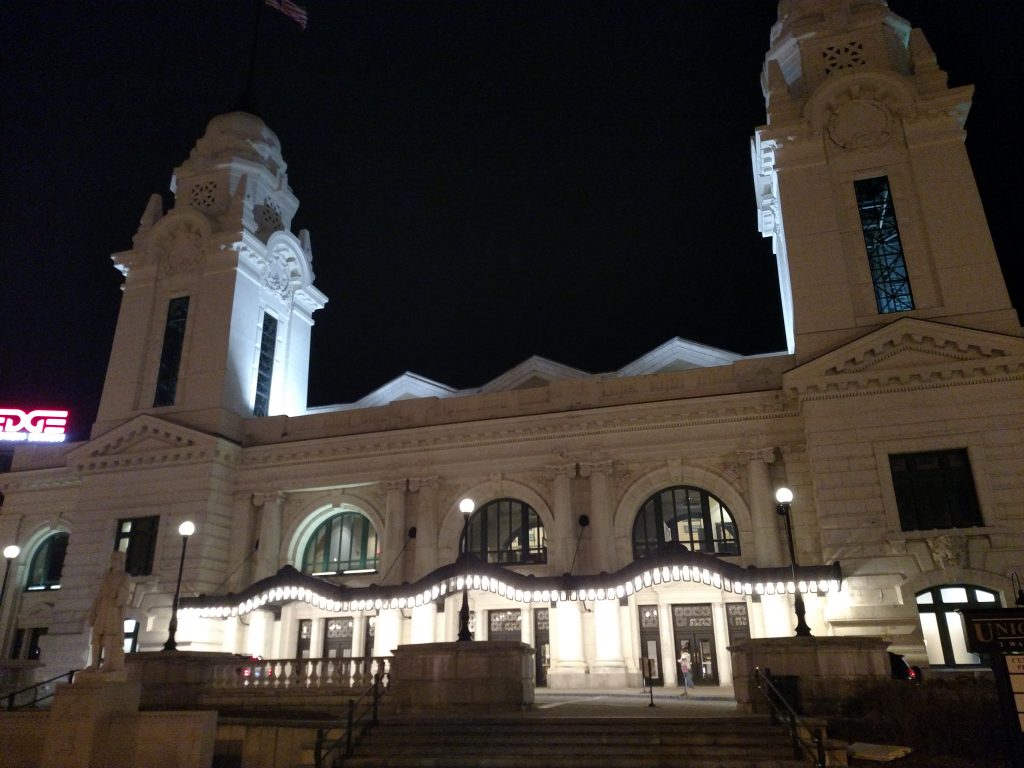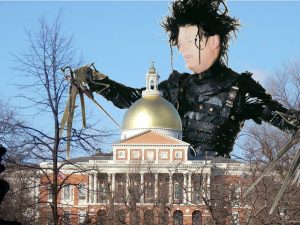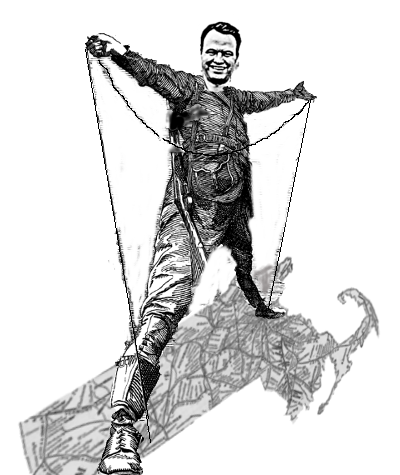Glimpses of East-West Rail, or a Position to Not Look Too Close…?

Worcester Union Station, “A Poem in Stone.” Could the city’s time as end of the line be in twilight? (WMassP&I)
WORCESTER—For much of the past few years, progress on a host of rail projects in Massachusetts has ground to a crawl. Last week Gov. Charlie Baker’s Department of Transportation, in laying out its rail plan for the coming decade on January 26, seemed to lift the speed restriction.
With projects divvied up among the department’s three tiers of priorities, there were clear winners and losers. Among the former was Western Mass, which saw key projects on the list including a study of expanded rail service between the 413 and Boston, a pet project of Longmeadow Senator Eric Lesser.
The sudden inclusion of East-West rail and pilot expansion of service between Springfield and Greenfield signaled a shift for the state. At hearings MassDOT held in in Worcester and Springfield last week as part of its public comment period, advocates embraced the changes, but displayed skepticism, too.

Baker’s budget pruning killed the rail study in 2016. (created with WMassP&I 20th Century Fox images)
The administration’s moves came after lobbying from Lesser, rail advocates and even Democratic gubernatorial contenders. Baker vetoed Lesser’s study in 2016 and it died in committee last year. Last year, he chartered a bus to Boston full of constituents to testify before the legislature’s Transportation Committee. Advocates of additional Greenfield service found their pleas met with little more than a polite reception.
Less fortunate were advocates for a station in Palmer. Construction of a rail station along the existing Chicago service that connect Boston and Springfield was rated Tier III, MassDOT’s lowest priority.
Groove Is in the Heart of the Commonwealth
Last Monday, in a conference room in Worcester’s slender regional transit building across from the city’s opulent Beaux-Arts rail station, MassDOT officials fielded questions about the proposed rail plan.
Senator Anne Gobi questioned why a rail station in Palmer, which she represents, received the lowest priority tier. Still she praised the movement on studying East-West rail. Gobi pressed officials for a timeline and whether Palmer could be folded into the study.

This Train Don’t Stop Here (Palmer Station) Anymore (via wikipedia)
Scott Hamwey, a MassDOT manager for long-term planning said officials were working on the study’s scope. “I don’t know that we’ve committed to a date by which the study would be up and running,” he told the senator. “But I can tell you that it is on our to-do list, but it is one of our priorities.”
Gobi’s office did not reply for a request for additional comment.
There was some frustration that rail service to New Bedford and Fall River, received a Tier I designation. The east-west rail study was Tier II.
Hamwey explained Tier I projects were essentially shovel-ready. Expanded service to Springfield was not. The commonwealth also lacks trackage rights west of Worcester. Thus, only Amtrak, which has rights, could extend service to Springfield at this time. Astrid Glynn, MassDOT’s rail chief, also pointed to an Albany Times-Union article that reported CSX denying its tracks were for sale.
The state acquired the tracks between Boston and Worcester starting in the 1960’s.
Posed with questions on the study, MassDOT spokesperson Patrick Marvin said, in a statement, “The Massachusetts Department of Transportation is committed to helping make sure that the state rail system efficiently serves the needs of the Commonwealth,” including freight and passengers. He added, “As laid out in the Draft State Rail Plan, MassDOT is moving forward to engage the public on future ideas.”
That doesn’t directly address the study, although it is clearly in the rail plan. MassDOT is expected to make more details available after the public comment period closes.
Don’t Stop Believin’ (in Rail)
At a press conference in Springfield hours before the Worcester hearing Monday, Lesser was sanguine about the study’s fate. “For decades people have asked for a link, for a link between Western Massachusetts and the red-hot economies all around us,” he said.
After his legislation requiring MassDOT to study East-West rail spent years languishing, the senator essentially declared victory on his marquee issue. “But we did have a breakthrough Friday,” he continued, referring to the 2018 draft rail plan inclusion of studying service between Springfield and Boston.
Since the rail plan’s release, he has exhorted supporters to continue pressuring MassDOT to ensure the study remained part of the plan. Yet, there seemed to be little doubt the study was going to happen.
“[Transportation Secretary [Stephanie] Pollack told me she wanted to study East-West rail,” Lesser said last Monday. “My bill is still pending in the legislature,” he added wryly.
However, the shape and scope of the study remains undefined. It will technically include review of Pittsfield, too, meaning engineering around the Berkshires factors in. Former Congressman John Olver noted, per reports, raised this point at Friday’s Springfield rail hearing.
What the service will be is another question. Lesser has often invoked the phrase “high-speed rail“—the phrase in his study legislation—but that is impractical along the existing line. Nobody is contemplating a new right-of-way either. More doable are upgrades to begin at or near the standards of Amtrak’s Northeast Regional or Maine’s Downeaster.
Given the suddenness of MassDOT’s turnaround, skeptics could reasonably wonder whether the agency will be studying pricey, but manageable upgrades or an unviable megaproject.
Lesser was not available for comment as of posting time. However, legislative sources expressed confidence the study would neither be smothered in a committee nor spiral out of control. Indeed, Lesser’s office may work with MassDOT on it. Those familiar with the subject say the goal is to lay groundwork for reasonably timely service competitive to driving, if not true high-speed bullet train or Acela-like service.
Let the River Line Run
MassDOT Connecticut River line pilot program will add a train between Springfield and Greenfield. Although MassDOT-owned, only the once daily Vermonter plods its way north of Springfield stopping in Holyoke, Northampton and Greenfield. Amtrak redirected the service, named after its sponsoring state, to this route to Vermont from another that only stopped in Amherst (it no longer does).
The Greenfield Recorder reported an existing Amtrak New Haven-Springfield Shuttle will continue on to Greenfield in May. Schedules will not be conducive to commuters, but it should suit day trippers to New York.
Amtrak referred questions, including those about Amtrak-state partnerships generally, to MassDOT. The department did not immediately a request for comment.
A 2008 federal law on states contracting with Amtrak to provide service likely governs the expansion.
went to #westernMA state rail plan hearing and a John Olver staff reunion broke out with yours truly, @adamghinds, and @SenStan in attendance along with the workhorse himself #mapoli pic.twitter.com/0CLoakaWio
— David Narkewicz (@DavidNarkewicz) February 2, 2018
Whatever the legal avenues, additional Connecticut River Line has been welcomed. Northampton mayor David Narkewicz, a leading voice on the service, feted MassDOT’s move.
“I am extremely pleased to see that expanded North-South passenger rail has been prioritized as a Tier 1 project in the draft 2018 State Rail Plan,” he said in testimony submitted to MassDOT. He highlighted stats showing ridership has exceeded expectations.
Narkewicz observed that $115 million in state and federal investment was intended to facilitate more than one train a day. He urged MassDOT to give the pilot program time. “I want to stress than any such pilot should be given at least a 3-5 year time period to successfully grow into a reliable and durable component of our regional transportation system,” he said in his testimony.
He Governs in Mysterious Ways

The Lake Shore Limited, the only rail connection between Boston and Springfield, lumbers westward near Boston Unviersity. (via wikipedia)
One big question hanging overhead is “why now?” Rail advocates have groused about the MassDOT’s inaction on Valley rail initiatives for years. The MBTA had been occupying a lot of attention, but that cannot entirely explain the sudden shift.
MassDOT did not address what prompted the shift in its comments to WMassP&I.
Rail advocates have described Secretary Pollack as trying to keep a lid on costly expenditures. That fits the Baker administration’s allergy to pursuing new revenue. Thus far, the arch-Democratic legislature has concurred. But this has effectively jammed statewide residents in traffic to avoiding raising their taxes even an iota.
Nonetheless, expanded rail service is also wildly popular, particularly in Western Mass. Meanwhile, the Democrats seeking their party’s nomination for governor, Jay Gonzalez, Bob Massie and Setti Warren, have vocally supported Lesser’s study and have highlighted transportation needs in the 413.
While Baker’s statewide approval remains stratospheric, some believe it is less so in Western Mass. Taking Western Mass rail matters off the table could mitigate any limpness in the governor’s local numbers.
Back at the Worcester hearing, there was palpable excitement, but some frustration, too. Attendees raised doubts about MassDOT’s commitment to expand South Station and pursue the North-South Rail Link. Others suggested money was really why some projects ended up on lowers tiers.
MassDOT’s transparency on the rail plan was also an issue. For example, Joseph Aiello, a transit advocate, mentioned the rail plan’s Friday night release and minimal meetings. That may have fueled concerns about the promised service, the study or whether the latter will lead to anything. Others focused on the rail plan and accompanying reports.
Ben Heckscher of Trains in the Valley told officials he would like MassDOT to release a final draft report that notes what changed from the initial draft. “It’s difficult to see what in substance has changed,” he said.
No one in the room promised to produce such a “redline” document.
